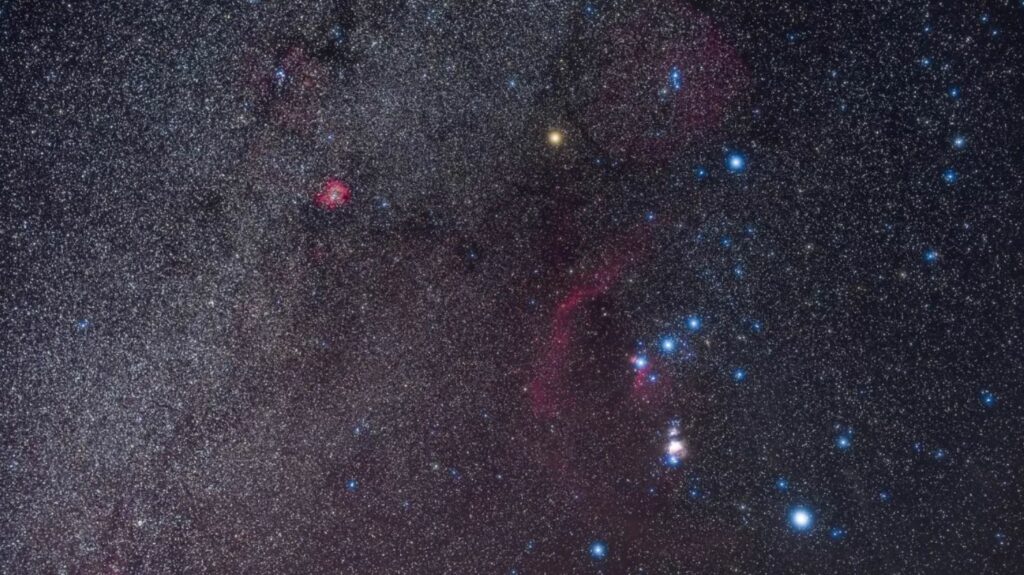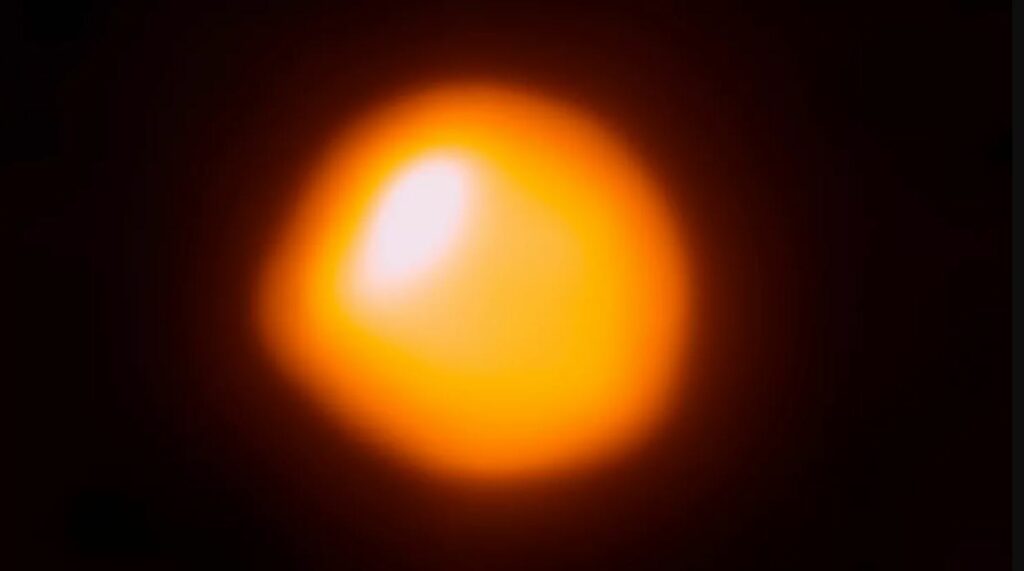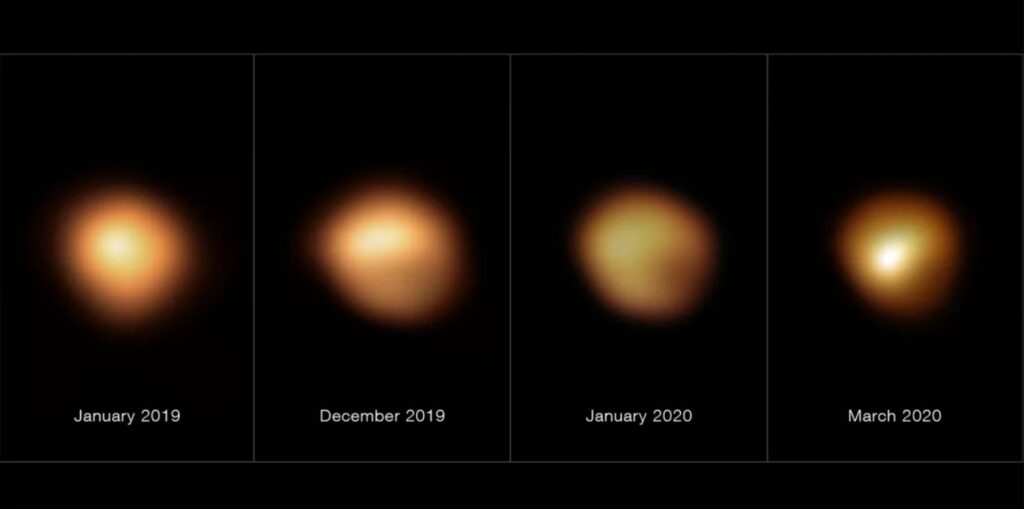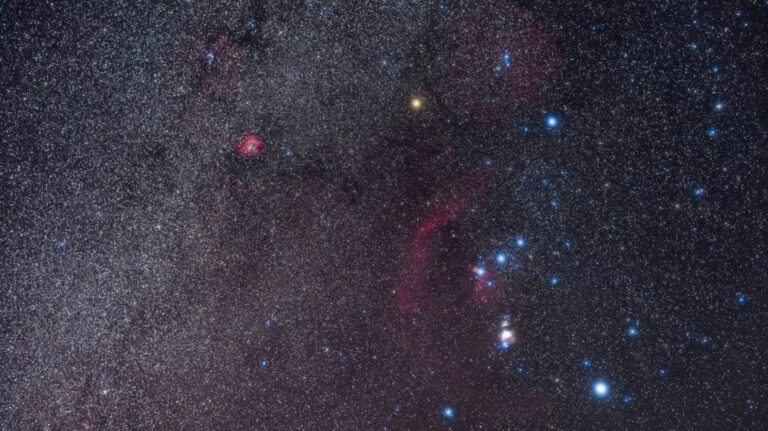Betelgeuse, the odd supergiant star, brightens: Supernova imminent?
The recent surge in brightness of Betelgeuse, one of the most luminous stars in the night sky, has sparked discussions about a potential supernova event. Could we anticipate witnessing this awe-inspiring celestial phenomenon?

Situated at the left shoulder of the prominent constellation Orion, Betelgeuse is a colossal star with a reddish hue, located approximately 650 light-years away from Earth. Normally ranking as the tenth-brightest star, Betelgeuse has ascended to the seventh position since early April. Currently, it shines at more than 140% of its usual brightness, as reported by Betelgeuse Status, a Twitter account dedicated to monitoring the star’s behavior.
As a red giant, Betelgeuse has exhausted its hydrogen fuel in the core and expanded significantly, surpassing its original size by hundreds of times. Astronomers suggest that the star is currently undergoing the fusion of helium into carbon and oxygen, a phase in its lifecycle that can persist for tens to hundreds of thousands of years before culminating in a supernova explosion. The recent fluctuations in Betelgeuse’s behavior, which commenced in 2019, have fueled speculation about the imminent occurrence of its spectacular demise. If Betelgeuse were to undergo a supernova, it would be the closest such event witnessed in over four centuries, radiating a brilliance so intense that it could potentially be visible even during daylight.
The great dimming
Betelgeuse, a variable star renowned for its regular cycles of brightness fluctuations, has been a subject of observation by astronomers for over a century. Traditionally, the star has displayed a pattern of brightening every 400 days, followed by a subsequent decrease to roughly half of its peak luminosity, only to brighten once more. However, in December 2019, Betelgeuse underwent an unprecedented dimming event, surpassing any previous observations, reaching a low point 2.5 times fainter than its typical minimum radiance. This occurrence, now referred to as the “Great Dimming,” was later attributed to an immense ejection of material from the star’s core, resulting in the formation of a vast dust cloud that obstructed our view of the star.
End of life
Following the Great Dimming event, Betelgeuse has partially regained its customary luminosity but has not fully returned to its previous state. Notably, the star’s cycle of brightness oscillation, which typically spans 400 days, has now shortened to 200 days. Additionally, observers have observed an additional phase of heightened brightness, arousing excitement among skywatchers. Nevertheless, astronomers interviewed by Space.com are urging caution when it comes to expectations of a supernova occurrence.
Morgan MacLeod, a postdoctoral fellow in theoretical astrophysics at Harvard University and the lead author of a recent study on Betelgeuse’s Great Dimming, explained that the most reliable models indicate that the star is currently in a phase where it is converting helium into carbon and oxygen within its core. According to these models, it is estimated that Betelgeuse is still tens of thousands or possibly even a hundred thousand years away from undergoing a supernova explosion.
MacLeod clarified that while a star’s primary life phase ends when it depletes its hydrogen fuel and commences fusing helium in its core, its existence as a red giant persists beyond the helium-burning stage. As the star exhausts its helium, it sustains itself by fusing carbon and oxygen into neon and magnesium, subsequently progressing to silicon fusion. Ultimately, the core of the star becomes enriched with iron, marking a critical turning point.
“Interestingly, the addition of helium nuclei to an iron atom absorbs energy rather than releasing it,” stated MacLeod. “Consequently, instead of a reaction that emits immense amounts of energy, the star’s core begins to absorb energy. This leads to a collapse of the star’s core, starting from the inside and progressing outward, which triggers what we refer to as a core-collapse supernova.”

The timescale of stellar death
While a star’s hydrogen-burning phase can extend over billions of years, each subsequent phase becomes progressively shorter. Miguel Montargès, an expert on Betelgeuse and a post-doctoral fellow at the Laboratory of Space Studies and Instrumentation in Astrophysics at the Paris Observatory, explained that the helium-burning phase typically lasts several hundred thousand years. This is followed by the next phase, which spans around 10,000 years, then progressively decreases to thousands of years, a century, and finally, a matter of days and hours just before the star’s explosion.
Similar to Morgan MacLeod, Montargès believes that Betelgeuse still has thousands of years of life remaining and is not greatly concerned by its recent unexpected brightening. He mentioned that the star has reached similar levels of brightness in the past, albeit only for short durations.
“When comparing the current brightening to the Great Dimming, the difference is quite insignificant,” stated Montargès. “During the Great Dimming, the star’s magnitude, which measures its brightness on a logarithmic scale inversely proportional to its visible brightness, decreased from 0.8 to 1.75. In contrast, the usual peak brightness is around 0.3, and we are currently only at approximately 0.1.”
Back to normal
In a paper published on the online repository Arxiv on May 16, MacLeod and colleagues present an alternative perspective, suggesting that Betelgeuse is not on the verge of a supernova but will likely return to its typical behavior within the next five to 10 years. They anticipate a gradual restoration of the star’s cycle of brightening and dimming to its normal duration of 400 days.
According to MacLeod, the alteration in the cycle duration is believed to be connected to the event that triggered the Great Dimming. It is hypothesized that a colossal outburst from the star’s interior, preceding the dimming event, caused the star’s envelope and internal regions to move in opposing directions. As a result, Betelgeuse is presently pulsating at twice the speed compared to its regular cycle.
Betelgeuse stands as an immense star, with a size so vast that if it were positioned at the center of our solar system, it would stretch beyond Jupiter. This substantial size, combined with its location within the Milky Way galaxy, enables astronomers to scrutinize Betelgeuse with greater detail than most other stars.
MacLeod explained that unlike the majority of stars, which appear as mere points of light, Betelgeuse can be resolved using instruments such as the Hubble Space Telescope and radio telescopes. The images captured unveil a remarkable entity that deviates from the smooth, spherical structure of our sun. Betelgeuse is characterized by uneven clusters of boiling gas bubbles, some comparable in size to small stars. Enormous plumes of hot material surge from the star’s core to its surface, eventually cooling down and vanishing back into the interior. This behavior resembles the sun’s activity on an intensified scale. Periodically, Betelgeuse releases a bubble of such magnitude that it triggers the phenomenon known as the Great Dimming. However, all these peculiarities do not necessarily imply that the star is on the brink of explosion, unless, of course, the assumptions made by astronomers prove to be incorrect.

If Betelgeuse were about to go supernova, would we know?
With the aid of advanced telescopes, astronomers possess the capability to observe and examine the outer layers of Betelgeuse with remarkable precision, enabling them to analyze the star’s atmospheric composition. However, the inner workings of the star’s core remain elusive, leaving astronomers uncertain about the exact processes taking place within. Questions arise regarding whether Betelgeuse is truly undergoing helium fusion or if it has transitioned to carbon fusion. Moreover, if a transition did occur, how could such a change be detected?
Miguel Montargès highlights that much of our understanding about Betelgeuse is derived from observations of other red giant stars. For instance, VY Canis Majoris, another red giant located in the Milky Way, approximately 3,900 light-years away from Earth, is believed to be much closer to its eventual demise compared to Betelgeuse. However, unlike Betelgeuse’s recent brightening, VY Canis Majoris has exhibited a consistent dimming trend over the past century.
“VY Canis Majoris used to be visible to the naked eye a hundred years ago,” Montargès explained. “Yet, due to the substantial material it has expelled, we can now only observe it in the infrared spectrum. This expulsion of material is what we anticipate to witness as a star approaches the supernova explosion. VY Canis Majoris has already shed about 60% of its initial mass, whereas Betelgeuse still retains approximately 95% of its original material.”
Montargès further noted that historical records indicate Betelgeuse was described as a yellow star until around 2,000 years ago when poets began depicting it as red. This transition, according to Montargès, suggests that Betelgeuse may be in the early stages of its evolution as a red giant.
Second sun
However, Montargès acknowledges the excitement surrounding the potential demise of Betelgeuse. When the star eventually explodes, it will undoubtedly capture widespread attention, making headlines for months on end.
“When the event occurs, the star will radiate a brilliance comparable to that of the full moon, except it will be concentrated in a single point,” Montargès explained. “For approximately two months, its luminosity will be so intense that, under clear skies and in a city devoid of artificial lighting, one would be able to read a book by the light of the supernova. It will be remarkably bright, even visible during daylight hours. Another star will grace the sky in broad daylight.”
Thankfully, while Betelgeuse is close enough to offer such a spectacular display, it is situated at a safe distance from Earth, rendering its explosion harmless to us. Astronomers suggest that a massive star would need to explode within 160 light-years of our planet for us to experience any significant effects from the explosion, according to EarthSky.
The most recent supernova known to have occurred within the Milky Way galaxy was SN 1604, commonly referred to as the Kepler supernova. Named after the renowned astronomer Johannes Kepler, who documented it in his book “De Stella Nova,” this supernova, situated 30 times farther away from Earth than Betelgeuse, remained visible even during daylight for over three weeks, as per historical records.
Montargès anticipates that Betelgeuse will soon resume its regular behavior. Over the next few months, the star will become invisible due to its proximity to the sun. Astronomers will have to wait until the end of summer to assess its progress and ascertain any notable changes.
“If, by September, Betelgeuse remains as bright as it is now or becomes even brighter, then we may start pondering the reasons behind it,” Montargès remarked. “However, from my perspective, I don’t find it particularly intriguing at this stage.”
Do not forget to share your opinion with us to provide you with the best posts !




0 Comments